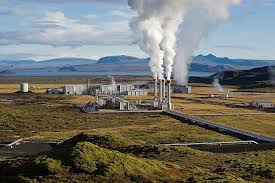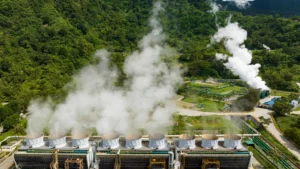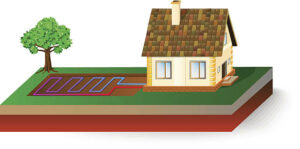Have you ever wondered how two renewable energy sources can team up to make a bigger impact? Geothermal and solar energy might seem like two completely different systems, but when they join forces, the results are nothing short of amazing. Together, they offer a sustainable and efficient way to power our lives while keeping the planet happy. Let’s break down how this dynamic duo works and why it’s a game-changer for clean energy.
What Is Geothermal Energy?
Before we talk about the partnership, let’s get to know our first star—geothermal energy. Geothermal energy comes from the heat stored beneath the Earth’s surface. Imagine tapping into a natural underground furnace to generate electricity or heat your home. Cool, right?
Geothermal systems use wells to access hot water or steam from deep underground. This heat can then be used to drive turbines and generate electricity or provide direct heating. The beauty of geothermal energy? It’s constant and doesn’t depend on the weather. Whether it’s sunny, rainy, or snowy, geothermal keeps delivering.
The Basics of Solar Energy
Now, meet the other half of our power couple: solar energy. You’ve probably seen those shiny panels on rooftops soaking up the sun. That’s solar energy in action. Solar panels, also known as photovoltaic (PV) cells, convert sunlight into electricity. The sun’s rays are free, abundant, and clean—what’s not to love?
But there’s a catch. Solar energy is a bit of a diva; it works best when the sun is shining. Cloudy days and nighttime can put a damper on its performance.
The Magic of Combining Geothermal and Solar Energy
So, how do these two energy sources complement each other? Think of it like peanut butter and jelly. On their own, they’re great. But together? Pure magic. Here’s how it works:
1. Filling Each Other’s Gaps
Solar energy is fantastic during sunny days, but it takes a back seat at night. Geothermal, on the other hand, is always on—day or night, rain or shine. By combining these two, you get a consistent energy supply. Solar handles the daytime load, while geothermal steps in to keep things running after sunset.
2. Reducing Carbon Footprints
Both geothermal and solar energy are environmentally friendly. By using them together, we can significantly cut down on the reliance on fossil fuels. It’s like a double punch to carbon emissions, making the planet breathe a little easier.
3. Lowering Energy Costs
Want to save money on energy bills? Of course, you do. Combining geothermal and solar systems can reduce costs over time. Solar panels can generate electricity to power a geothermal heat pump, making the system even more efficient. It’s an investment upfront, but the long-term savings are worth it.
4. Boosting Energy Independence
When you pair geothermal with solar, you’re less dependent on the grid. That means fewer power outages and more control over your energy needs. Plus, it’s a step toward energy independence for communities and homeowners alike.
Real-Life Applications
Curious about how this works in the real world? Let’s look at a few examples:
Residential Use
Imagine your home powered by the sun during the day and heated by geothermal energy at night. Solar panels can supply electricity for your lights, appliances, and even charge your electric car. Meanwhile, a geothermal heat pump keeps your home warm in winter and cool in summer. It’s a win-win.
Commercial and Industrial Applications
Big businesses and factories can also benefit from this combo. For instance, a factory might use solar panels to generate electricity during operational hours and geothermal energy to manage heating and cooling needs. This setup not only saves money but also showcases a commitment to sustainability.
Community Energy Projects
In some areas, entire communities are turning to combined geothermal and solar systems. These projects provide reliable, affordable, and clean energy to dozens or even hundreds of households. It’s like a renewable energy co-op, where everyone shares the benefits.
Challenges and Solutions
Of course, no system is perfect. Combining geothermal and solar energy comes with its own set of challenges. Let’s tackle them head-on:
High Initial Costs
The upfront costs for installing both geothermal and solar systems can be steep. But don’t let the sticker shock scare you. Government incentives, tax credits, and financing options can help ease the burden. Plus, the savings over time make it a smart investment.
Space Requirements
Solar panels need space, whether it’s your roof or a nearby plot of land. Geothermal systems require drilling, which isn’t feasible in all locations. However, with careful planning and site assessment, these hurdles can often be overcome.
Technical Expertise
Combining these systems requires skilled professionals who understand both technologies. But as renewable energy becomes more popular, finding experts is getting easier. Companies like EnviroTechGeo specialize in making these systems work seamlessly together.
The Future of Renewable Energy
Looking ahead, the combination of geothermal and solar energy is poised to play a big role in the renewable energy landscape. With advancements in technology and growing awareness about climate change, more people and businesses are exploring this powerful pairing. The potential for innovation is enormous, from smart energy grids to hybrid systems that integrate multiple renewable sources.
Conclusion
Geothermal and solar energy are like the ultimate tag team in the renewable energy world. They complement each other’s strengths and fill in the gaps, creating a reliable, efficient, and eco-friendly energy solution. Whether you’re a homeowner looking to cut energy costs, a business aiming for sustainability, or a community striving for energy independence, this combination has something to offer.


